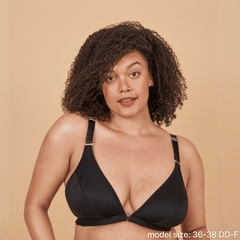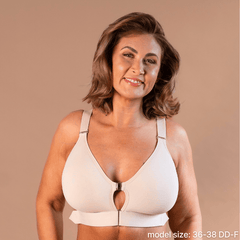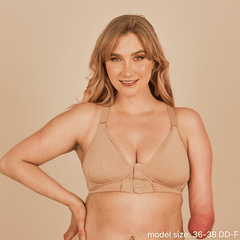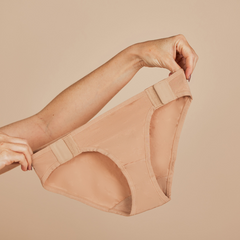
If you've ever shopped for a bra, you're probably familiar with the confusing world of bra cup sizes. What do those letters actually mean? And how do you figure out what size is right for you? In this article, we'll demystify bra cup sizes once and for all.
A bra cup size is a letter (ranging from A to Z) that represents the difference between your bust measurement and your underbust measurement. It's essentially a measure of volume or how much space your breast tissue takes up. The cup sizes increase in volume as the letters go up for example from B to C to D. However, it's closely tied to your ribcage size too.
Understanding your bra cup size is essential for finding a bra that fits well and provides the necessary support. Wearing an ill-fitting bra can lead to discomfort, pain, and even long-term health issues.
Whether you're looking to buy a new bra or simply curious about how cup sizes work, this article will give you all the information you need. So, let's dive in and unravel the mysteries of bra cup sizes.
How bra cup sizes are determined

Bra cup sizes are determined by a combination of two key measurements: the underband size and the bust size. The underbust is the circumference of a person's ribcage just beneath the bust, while the bust size is the measurement around the fullest part of the breasts.
The underbust measurement is then changed into the band size, which varies by brand. Some brands add “+1” to odd numbers and some add more. It heavily depends on the brand as there’s no sizing consistency in the lingerie industry.
Cup size is then calculated by subtracting the band size from the bust measurement. Each inch of difference corresponds to a cup size, with letters of the alphabet used to represent these sizes.
For example, if the bust measurement is four inches larger than the band measurement, the cup size would typically be a "D." Therefore, the larger the difference between the bust and band measurements, the larger the cup size.
It's important to note that cup sizes are relative to the band size, meaning a "C" cup on a smaller band size will be smaller than a "C" cup on a larger band size. This system allows for a range of cup sizes to accommodate the diverse shapes and sizes of individuals' breasts, ensuring a more comfortable and supportive fit.
Common misconceptions about bra cup sizes

Common misconceptions about bra cup sizes often lead to confusion and frustration among individuals.
One prevalent misunderstanding is that cup size is an absolute measurement of breast volume. In reality, cup size is relative to the band size, so a 42B breast will likely be bigger than a 32D.
Another misconception is that all bras with the same cup size will fit the same, but the design, style, and brand of a bra can significantly affect the fit.
Additionally, many people believe that cup sizes are limited to A, B, C, D, etc., without realizing that the sizing system extends with double letters (e.g., DD, DDD) and even to a Z cup.
Lastly, it's important to dispel the myth that a larger cup size is inherently better or more attractive; the ideal size is the one that provides comfort and support for an individual's unique body shape, and beauty comes in all sizes.
How to know if you’re in the right size cup

Determining whether you're in the right size cup is crucial for both comfort and support. To check if you're wearing the correct cup size, start by examining the fit. The cup should smoothly encase your breast without any intense wrinkling or spillage, creating a natural shape.
There should be no gaping or empty spaces at the front, sides, or bottom of the cup. The underwire, if present, should sit flat against your ribcage, following the natural curve of your breast and not digging into your chest.
Additionally, pay attention to how the band feels; it should provide firm support without feeling overly tight or riding up your back. Remember that cup size is relative to the band size, so if you change one, you may need to adjust the other accordingly.
Lastly, trust your comfort level; if the bra feels uncomfortable, causes pain, or leaves marks on your skin, it's a sign that you may need a different size. Consulting a professional bra fitter can also be immensely helpful in ensuring you're in the right cup size.
Finding the right bra cup size for you

Start by measuring your underbust size by wrapping a tape measure snugly around your ribcage just beneath your bust. Ensure the tape measure is parallel to the ground and neither too tight nor too loose. Use this measurement to determine your band size in that brand.
Next, measure your bust size by placing the tape measure around the fullest part of your breasts, making sure it's parallel to the ground and not squeezing your breasts.
Subtract your band size from your bust measurement to determine your cup size. Each inch of difference corresponds to a cup size, with letters from A to Z used to denote various sizes.
Something to keep in mind is that this is the American and UK system of measurement. Some countries use a different system, so you should check the sizing of the brand you’re interested in.
Tips for measuring your bra cup size accurately

To ensure precision, follow these tips: First, wear a well-fitting, non-padded, non-compression bra or no bra at all when measuring. Use a soft measuring tape to obtain the most accurate measurements.
Measure your underband by wrapping the tape firmly around your ribcage just beneath your bust, ensuring it's snug but not tight, and the tape is parallel to the ground. Write down this measurement in inches. Then, convert it into the brand’s band size.
Next, measure your bust size by placing the tape around the fullest part of your breasts while keeping it parallel to the ground. Make sure the tape is snug but not constricting. If your breasts have a pendulous shape, you may want to lean forward at a 90 degree angle, if this is within your range of motion. If it’s not, then you should measure while wearing your best fitting bra.
Note this measurement as well. To find your cup size, subtract your band size from your bust measurement. Each inch of difference corresponds to a cup size, with letters of the alphabet (A, B, C, etc.) used to represent these sizes. In the US, we use D, DD, and DDD/F, while in the UK they use an E instead of a DD.
Remember that finding the right cup size is a process of trial and error, and you may need to experiment with different sizes and styles to discover your perfect fit.
If you'd like to learn more, we recommend reading The Ultimate Guide: How Bra Size is Measured.
The impact of weight gain/loss and hormones on bra cup size

Weight gain, weight loss, and hormonal fluctuations can all have a significant impact on a person's bra cup size. It’s completely normal to fluctuate in size throughout your life and even within a one month period, but it’s just something to note.
When individuals gain weight, it often results in an increase in fat tissue throughout the body, including the breast area. This can lead to an increase in cup size as the breasts become larger.
Conversely, weight loss can result in a reduction of breast size as fat is lost from the breasts. Hormonal changes, such as those that occur during pregnancy, menstruation, menopause, or when taking certain medications, can also affect breast size and fullness.
For example, during pregnancy and menstruation, breast tissue can swell and temporarily increase cup size due to hormonal shifts.
Understanding these factors and their potential effects on bra size is important for individuals to ensure they are wearing a well-fitting bra that provides the necessary support and comfort throughout these natural changes in their bodies.
If your body has not been fitting into a bra it used to fit into well, determine whether you believe this is a temporary change or a more permanent one. If it’s more long-term or permanent, we’d recommend you find new bras.
Concluding Thoughts
In conclusion, understanding bra cup sizes is a vital step towards achieving comfort, confidence, and proper support in your lingerie. Ultimately, a well-fitting bra, regardless of the cup size, should make you feel comfortable and confident. Armed with this knowledge, you'll be better equipped to navigate the world of bras with ease and make choices that enhance both your style and comfort.



